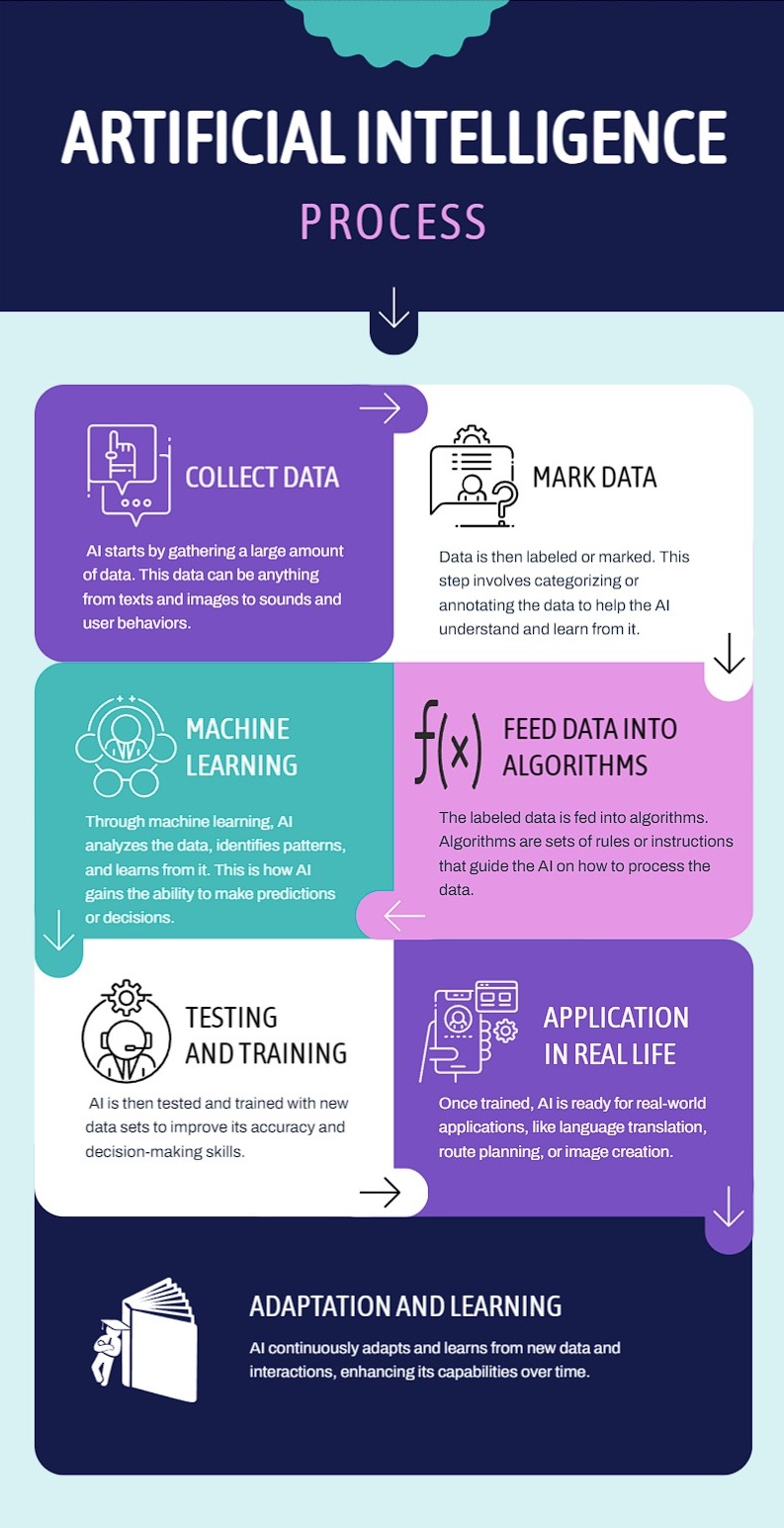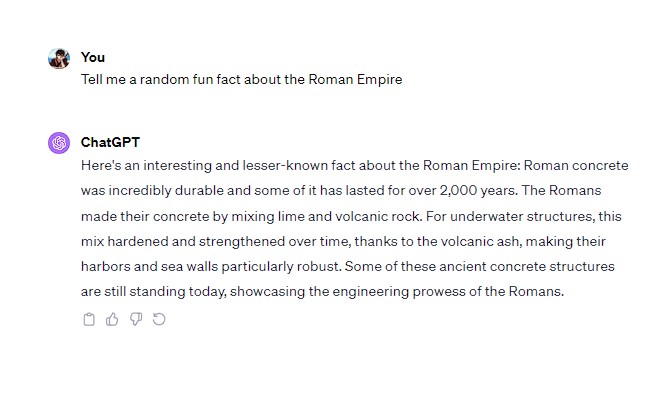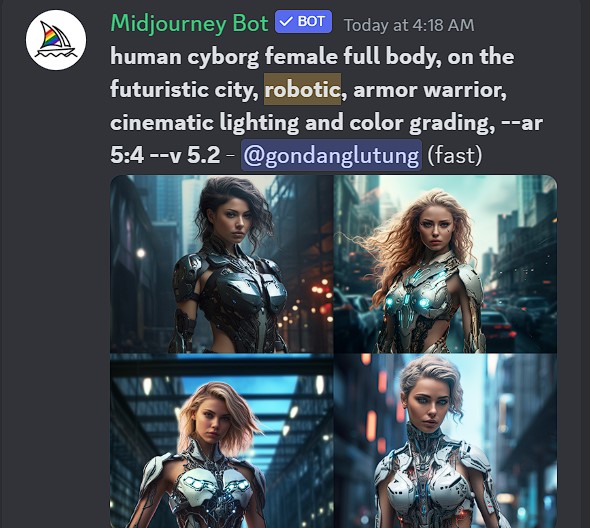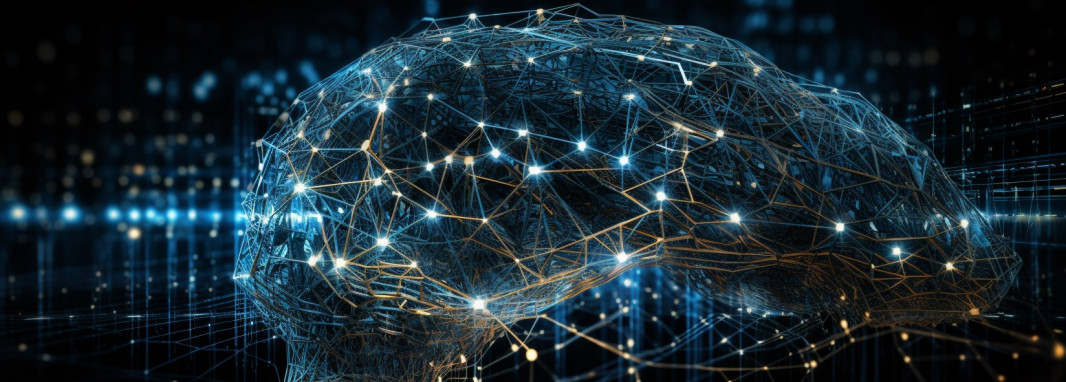The Dawn of a New Era: AI in Our Daily Lives
Imagine a world where your digital assistant not only schedules your meetings but also suggests the perfect gift for a friend's birthday based on their interests.
Or picture a scenario where, with just a few typed words, you can generate a stunning artwork that perfectly encapsulates the mood you wish to convey. This isn't a peek into a distant, sci-fi future; this is our present, richly interwoven with Artificial Intelligence (AI).
AI, a term that once conjured images of robots and science fiction, is now an integral part of our daily lives. AI's influence is pervasive, from the smartphone in your pocket to how businesses make decisions.
It's revolutionizing industries, altering the job market, and reshaping the way we interact with the world. But amidst this change, a fundamental question arises: How does AI work?
This article aims to demystify the intricate workings of AI, not through complex jargon, but by exploring its application in technologies you might already be familiar with or have heard about.
We'll delve into the mechanics behind groundbreaking AI technologies like ChatGPT, an AI that converses like a human, Midjourney, an AI that optimizes travel routes, and DALL-E, an AI that creates images from textual descriptions.
Through these examples, we'll uncover the layers of data, algorithms, and machine learning that power these intelligent systems, offering you a clear, concise understanding of the fascinating world of AI.
Join us on this journey to unravel the mystery of AI and discover how it's shaping the fabric of our reality.
The Basics of AI Functionality

Data and Learning: The Fuel of Artificial Intelligence
At the heart of every AI system is a fundamental need: data. Think of data as the food that nourishes AI, enabling it to grow and function. Artificial Intelligence, in its simplest form, is about pattern recognition and decision-making.
But how does it recognize these patterns? The answer lies in the data fed into these systems.
When we talk about data in the context of AI, we're referring to everything from text and images to sounds and real-world behaviors. For instance, to teach an AI language model like ChatGPT, developers feed it vast amounts of text data.
This data acts as a training ground where the AI learns various aspects of human language, from grammar to cultural nuances. AI systems can make predictions or decisions based on new, unseen data by analyzing and learning from this data. Using direct preference optimization, these systems become more efficient at predicting the most relevant outcomes.
It's like learning to cook by observing numerous chefs at work; once you understand the patterns and techniques, you can start cooking independently.
Algorithms: The 'Brain' Behind AI Decision-Making
If data is the food for AI, algorithms are the brain that decides how to digest it. An algorithm in AI is a set of rules or instructions that the AI follows to process data and make decisions.
It's like a recipe that guides the AI using the information it has learned from the data. These algorithms can range from simple, rule-based instructions to complex frameworks enabling AI to learn and adapt over time.
The beauty of these algorithms in AI is their ability to follow instructions and learn from the outcomes of their decisions.
This ability to understand and improve makes AI systems like ChatGPT so fascinating and valuable in various applications, from customer service to content creation.
Machine Learning and Neural Networks: The Core of AI Development
Now, let's dive into two terms often tossed around when discussing AI: machine learning and neural networks. Machine learning is a subset of artificial intelligence that focuses on building systems that learn from and adapt to data over time.
It's like teaching a child through experience; as the AI is exposed to more data, it becomes better at making predictions or decisions.
Neural networks, conversely, are a specific type of machine learning inspired by the human brain. They consist of interconnected 'nodes' layers that simulate how human neurons function.
These networks process input data, like images or text, and through their complex connections, produce an output. Neural networks are the backbone of many advanced AI systems, enabling them to perform tasks like recognizing speech, translating languages, or generating realistic images in tools like DALL-E.
In summary, the functionality of AI boils down to a synergy of data and algorithms refined through machine learning and neural networks.
This combination allows artificial intelligence to mimic human-like behavior and develop and evolve in its capabilities, leading to the innovative AI-driven technologies we see today.
How ChatGPT Works?

Overview: ChatGPT - The AI Language Prodigy
ChatGPT stands as a shining example of the advancements in AI language understanding and generation.
This AI language model, developed by OpenAI, is designed to understand and respond to human language in a way that's remarkably coherent and contextually relevant. The 'GPT' in ChatGPT stands for 'Generative Pre-trained Transformer,' which is a bit of a mouthful, but it essentially means that this AI is incredibly adept at generating text based on the input it receives.
Data Training: The Foundation of ChatGPT's Linguistic Skills
The ChatGPT training is akin to an intensive language and culture course but on an enormous scale. It was trained using a colossal dataset composed of a diverse range of internet text.
This dataset includes everything from books and websites to articles and social media posts. By analyzing this vast array of text, ChatGPT learned not just the basics of language syntax and grammar but also the nuances, idioms, and varied human communication styles. This is why it's able to both write engaging posts that improve your social media engagement metrics and help you write your thesis.
This training process allows ChatGPT to understand and generate text across various topics and in various tones. Whether it's answering a technical query, composing a poem, or engaging in casual banter, ChatGPT's responses are informed by the massive amount of information it has digested. This extensive training is what makes ChatGPT a versatile tool in content creation, customer service, and even as an educational assistant.
Interactivity: Learning from Each Conversation
One of the most fascinating aspects of ChatGPT is its ability to interact conversationally. Unlike traditional search engines that simply fetch answers, ChatGPT engages in a dialogue. It can understand the context of a conversation, remember previous exchanges within that interaction, and respond in a manner that's both relevant and often surprisingly insightful.
Furthermore, each interaction with a user is an opportunity for ChatGPT to learn and refine its understanding and responses.
While it doesn't learn in real-time from individual users (due to privacy and ethical considerations), the feedback and data gathered en masse are used to periodically update and improve its models.
This iterative learning process ensures that ChatGPT continues to evolve, becoming more sophisticated and accurate in its language abilities.
In essence, ChatGPT embodies the remarkable capabilities of modern AI in understanding and generating human language.
Its development and functionality showcase not just the power of extensive data training and advanced algorithms but also the potential of AI to interact with and adapt to the complexities of human communication.
How Midjourney Works?

Function: Midjourney - The AI Route Planner
Midjourney stands out as an innovative application of AI in journey or route planning. Unlike conventional GPS systems, Midjourney leverages artificial intelligence to optimize travel routes, making your trip faster, safer, and more efficient. This can be super helpful if you're taking a family vacation with an RV rental and exploring an unknown location. It's like having a personal travel assistant who knows the roads better than anyone else.
Data Utilization: Crafting the Perfect Route with AI
The secret to Midjourney's effectiveness lies in its use of diverse data sets. It analyzes various information, including detailed maps, current traffic patterns, historical traffic data, and even user preferences and driving habits.
By synthesizing this information, Midjourney can suggest the most optimal routes for users.
Imagine you're planning to drive across the city during rush hour. Midjourney will evaluate current traffic conditions, predict potential delays, and consider your previous route preferences to suggest the best path.
This AI-driven approach ensures a more personalized and adaptive routing experience compared to traditional navigation systems.
Adaptation: Responding to Real-Time Road Conditions
What sets Midjourney apart is its ability to adapt to real-time changes. As traffic conditions fluctuate due to accidents, construction, or other unforeseen events, Midjourney dynamically adjusts your route.
This adaptability ensures that you're always on the most efficient path to your destination, saving time and reducing the stress of unexpected road delays.
How DALL-E Works?

Concept: DALL-E - The AI Artist
DALL-E represents a groundbreaking leap in AI capabilities, functioning as an image generation model. This AI tool, also developed by OpenAI, can create images from textual descriptions.
It's like an artist who can bring any scene you describe to life, only that the artist is an AI model.
Image Creation Process: Turning Words into Visual Art
The process behind DALL-E's image creation is as fascinating as the images it produces. DALL-E was trained on a vast dataset of images and their corresponding captions, which taught it to understand and visualize a wide range of concepts from simple text descriptions. When you provide a prompt to DALL-E, the AI analyses the text, identifies key elements and themes, and then generates an image corresponding to that description.
For example, if you ask DALL-E to create an image of a 'futuristic cityscape at sunset,' it will use its understanding of what cities, futurism, and sunsets look like to generate a unique image that combines these elements.
This process showcases the AI's ability to interpret and visually express ideas, a task once thought to be exclusively human.
Creativity and Limitations: The Artistic Range of DALL-E
DALL-E's creativity is evident in the diverse and often surprising images it generates. It can create anything from realistic photographs to surreal and abstract compositions. However, it's essential to recognize DALL-E's limitations as well.
The AI's creations are only as good as the data it was trained on, and it may sometimes interpret prompts in unexpected ways. Additionally, ethical considerations around the generation of certain types of images are crucial, leading to inbuilt restrictions to prevent misuse.
In conclusion, both Midjourney and DALL-E serve as prime examples of AI's expanding capabilities.
From optimizing our travels to transforming our creative ideas into visual realities, these AI tools demonstrate the vast potential and growing sophistication of artificial intelligence in our everyday lives.
AI in Action
Real-life Implications: AI Transforming Our World
The practical implications of AI technologies like ChatGPT, Midjourney, and DALL-E in our everyday lives are profound and far-reaching. AI is no longer a futuristic concept; it's a present reality, actively shaping various facets of our existence.
ChatGPT, for instance, is revolutionizing how we interact with information, providing personalized and interactive responses to queries, aiding education, and even assisting in creative writing.
Midjourney, on the other hand, is enhancing our travel experiences by making them more efficient and less stressful. DALL-E pushes the boundaries of creativity, allowing us to visualize ideas and concepts previously only in our imaginations.
The influence of these technologies extends beyond individual use.
Businesses leverage AI for better customer service, more targeted marketing, and improved operational efficiency. In healthcare, AI is enabling faster and more accurate diagnoses. In education, AI tools are providing personalized learning experiences.
The ripple effect of AI's capabilities is touching every corner of our society.
Ethical Considerations: Navigating the AI Landscape
With the growing influence of AI comes a set of ethical considerations. For instance, the creation and use of AI-generated content raises questions about authenticity, intellectual property, and the potential for misinformation.
Decision-making by AI, especially in critical areas like healthcare or law enforcement, underscores the need for transparency, fairness, and accountability in AI systems.
As we embrace AI technologies, it's crucial to consider their societal impact, data privacy issues, and the potential for biases in AI models. These considerations remind us that while AI can be a powerful tool, it must be used responsibly and ethically.
Conclusion
Harnessing AI: A Journey of Innovation and Transformation
In exploring AI technologies such as ChatGPT, Midjourney, and DALL-E, we've seen how AI works as a theoretical concept and a practical tool transforming our world.
These technologies, powered by sophisticated algorithms and vast amounts of data, enable machines to perform tasks that were once thought to be exclusively human domains.
The journey through the realms of AI language models, route optimization, and image generation has given us a glimpse into artificial intelligence's incredible capabilities and potential.
It's an exciting time in the field of AI, with innovations continually emerging and pushing the boundaries of what's possible.
As we move forward in this era of rapid technological advancement, let's maintain a sense of curiosity and openness toward AI and its evolving role. There's much more to discover about AI's impact on our lives and our future.
The AI journey is just beginning, and each of us has the opportunity to be a part of this transformative journey.
At Zfort Group, we are at the forefront of this exciting field, offering cutting-edge artificial intelligence development services. Our team of experts specializes in harnessing the power of AI to create innovative solutions tailored to your unique needs.
Whether it's developing intelligent language models, optimizing routes with advanced algorithms, or creating visually stunning AI-generated images, we are dedicated to pushing the boundaries of AI technology.
Let's embrace the possibilities together and contribute to shaping a future where AI augments our capabilities and enriches our human experience. With our expertise and your vision, the potential for transformation is limitless. Join us in shaping the future of AI.





